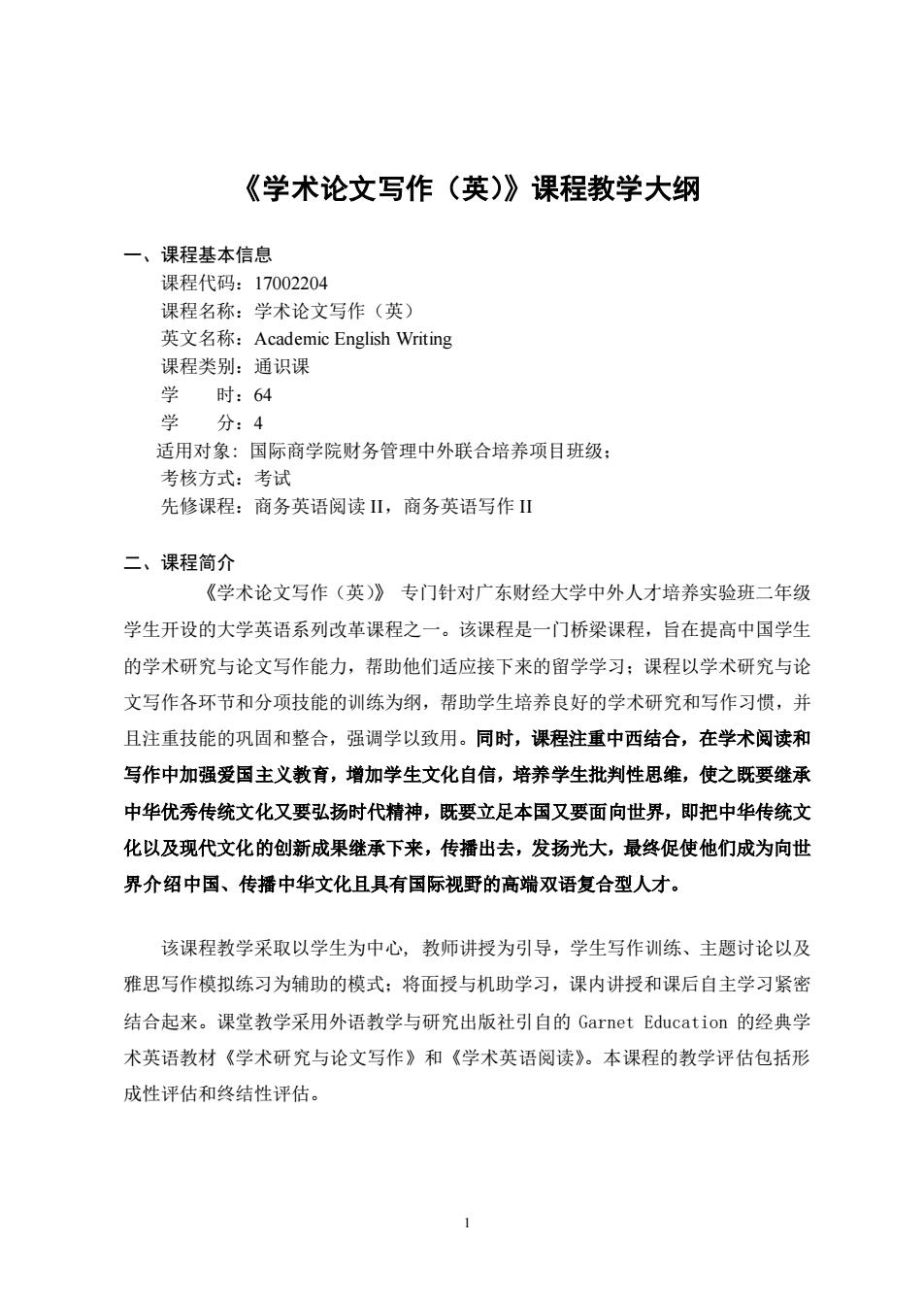
《学术论文写作(英)》课程教学大纲 一、课程基本信息 课程代码:17002204 课程名称:学术论文写作(英) 英文名称:Academic English Writing 程类别:通识课 学 时:64 学 分分:4 适用对象:国际商学院财务管理中外联合培养项目班级 考核方式:考试 先修课程:商务英语阅读Ⅱ,商务英语写作Ⅱ 二、课程简介 《学术论文写作(英)》专门针对广东财经大学中外人才培养实验班二年级 学生开设的大学英语系列改革课程之一。该课程是一门桥梁课程,旨在提高中国学生 的学术研究与论文写作能力,帮助他们适应接下来的留学学习:课程以学术研究与论 文写作各环节和分项技能的训练为纲,帮助学生培养良好的学术研究和写作习惯,并 且注重技能的巩固和整合,强调学以致用。同时,课程注重中西结合,在学术阅读和 写作中加强爱国主义教育,增加学生文化自信,培养学生批判性思维,使之既要继承 中华优秀传统文化又要弘扬时代精神,既要立足本国又要面向世界,即把中华传统文 化以及现代文化的创新成果继承下来,传播出去,发扬光大,最终促使他们成为向世 界介绍中国、传播中华文化且具有国际视野的高端双语复合型人才。 该课程教学采取以学生为中心,教师讲授为引导,学生写作训练、主题讨论以及 雅思写作模拟练习为辅助的模式:将面授与机助学习,课内讲授和课后自主学习紧密 结合起来。课堂教学采用外语教学与研究出版社引自的Garnet Education的经典学 术英语教材《学术研究与论文写作》和《学术英语阅读》。本课程的教学评估包括形 成性评估和终结性评估
1 《学术论文写作(英)》课程教学大纲 一、课程基本信息 课程代码:17002204 课程名称:学术论文写作(英) 英文名称:Academic English Writing 课程类别:通识课 学 时:64 学 分:4 适用对象: 国际商学院财务管理中外联合培养项目班级; 考核方式:考试 先修课程:商务英语阅读 II,商务英语写作 II 二、课程简介 《学术论文写作(英)》 专门针对广东财经大学中外人才培养实验班二年级 学生开设的大学英语系列改革课程之一。该课程是一门桥梁课程,旨在提高中国学生 的学术研究与论文写作能力,帮助他们适应接下来的留学学习;课程以学术研究与论 文写作各环节和分项技能的训练为纲,帮助学生培养良好的学术研究和写作习惯,并 且注重技能的巩固和整合,强调学以致用。同时,课程注重中西结合,在学术阅读和 写作中加强爱国主义教育,增加学生文化自信,培养学生批判性思维,使之既要继承 中华优秀传统文化又要弘扬时代精神,既要立足本国又要面向世界,即把中华传统文 化以及现代文化的创新成果继承下来,传播出去,发扬光大,最终促使他们成为向世 界介绍中国、传播中华文化且具有国际视野的高端双语复合型人才。 该课程教学采取以学生为中心, 教师讲授为引导,学生写作训练、主题讨论以及 雅思写作模拟练习为辅助的模式;将面授与机助学习,课内讲授和课后自主学习紧密 结合起来。课堂教学采用外语教学与研究出版社引自的 Garnet Education 的经典学 术英语教材《学术研究与论文写作》和《学术英语阅读》。本课程的教学评估包括形 成性评估和终结性评估
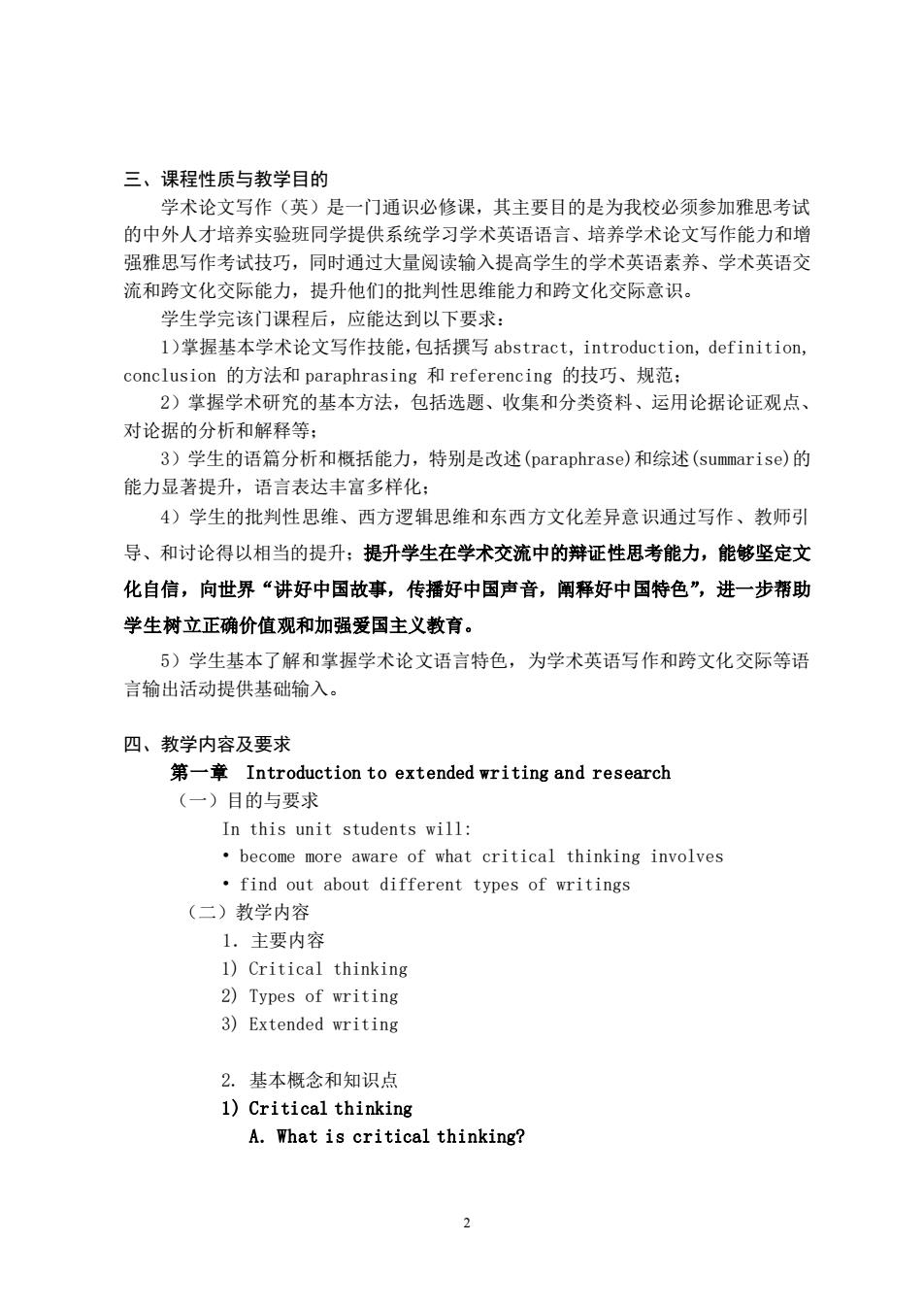
三、课程性质与教学目的 学术论文写作(英)是一门通识必修课,其主要目的是为我校必须参加雅思考试 的中外人才培养实验班同学提供系统学习学术英语语言、培养学术论文写作能力和增 强雅思写作考试技巧,同时通过大量阅读输入提高学生的学术英语素养、学术英语交 流和跨文化交际能力,提升他们的批判性思维能力和跨文化交际意识。 学生学完该门课程后,应能达到以下要求: I)掌握基本学术论文写作技能,包括撰写abstract,introduction,,definition conclusion的方法和paraphrasing和referencing的技巧、规范: 2)掌握学术研究的基本方法,句括洗颗、收集和分类资料、坛用论据论证观点 对论据的分析和解释等: 3)学生的语篇分析和概括能力,特别是改述(paraphrase)和综述(summarise)的 能力显著提升,语言表达丰富多样化: 4)学生的批判性思维、西方逻辑思维和东西方文化差异意识通过写作、教师引 导、和讨论得以相当的提升:提升学生在学术交流中的辩证性思考能力,能够坚定文 化自信,向世界“讲好中国故事,传播好中国声音,阐释好中国特色”,进一步帮助 学生树立正确价值观和加强爱国主义教育, 5)学生基本了解和掌握学术论文语言特色,为学术英语写作和跨文化交际等语 言输出活动提供基础输入。 四、教学内容及要求 第一章Introduction to extended writing and research (一)目的与要求 In this unit students will: become more aware of what critical thinking involves find out about different types of writings (二)教学内容 1.主要内容 1)Critical thinking 2)Types of writing 3)Extended writing 2.基本概念和知识点 1)Critical thinking A.What is critical thinking? 2
2 三、课程性质与教学目的 学术论文写作(英)是一门通识必修课,其主要目的是为我校必须参加雅思考试 的中外人才培养实验班同学提供系统学习学术英语语言、培养学术论文写作能力和增 强雅思写作考试技巧,同时通过大量阅读输入提高学生的学术英语素养、学术英语交 流和跨文化交际能力,提升他们的批判性思维能力和跨文化交际意识。 学生学完该门课程后,应能达到以下要求: 1)掌握基本学术论文写作技能,包括撰写 abstract, introduction, definition, conclusion 的方法和 paraphrasing 和 referencing 的技巧、规范; 2)掌握学术研究的基本方法,包括选题、收集和分类资料、运用论据论证观点、 对论据的分析和解释等; 3)学生的语篇分析和概括能力,特别是改述(paraphrase)和综述(summarise)的 能力显著提升,语言表达丰富多样化; 4)学生的批判性思维、西方逻辑思维和东西方文化差异意识通过写作、教师引 导、和讨论得以相当的提升;提升学生在学术交流中的辩证性思考能力,能够坚定文 化自信,向世界“讲好中国故事,传播好中国声音,阐释好中国特色”,进一步帮助 学生树立正确价值观和加强爱国主义教育。 5)学生基本了解和掌握学术论文语言特色,为学术英语写作和跨文化交际等语 言输出活动提供基础输入。 四、教学内容及要求 第一章 Introduction to extended writing and research (一)目的与要求 In this unit students will: • become more aware of what critical thinking involves • find out about different types of writings (二)教学内容 1.主要内容 1) Critical thinking 2) Types of writing 3) Extended writing 2. 基本概念和知识点 1) Critical thinking A. What is critical thinking?
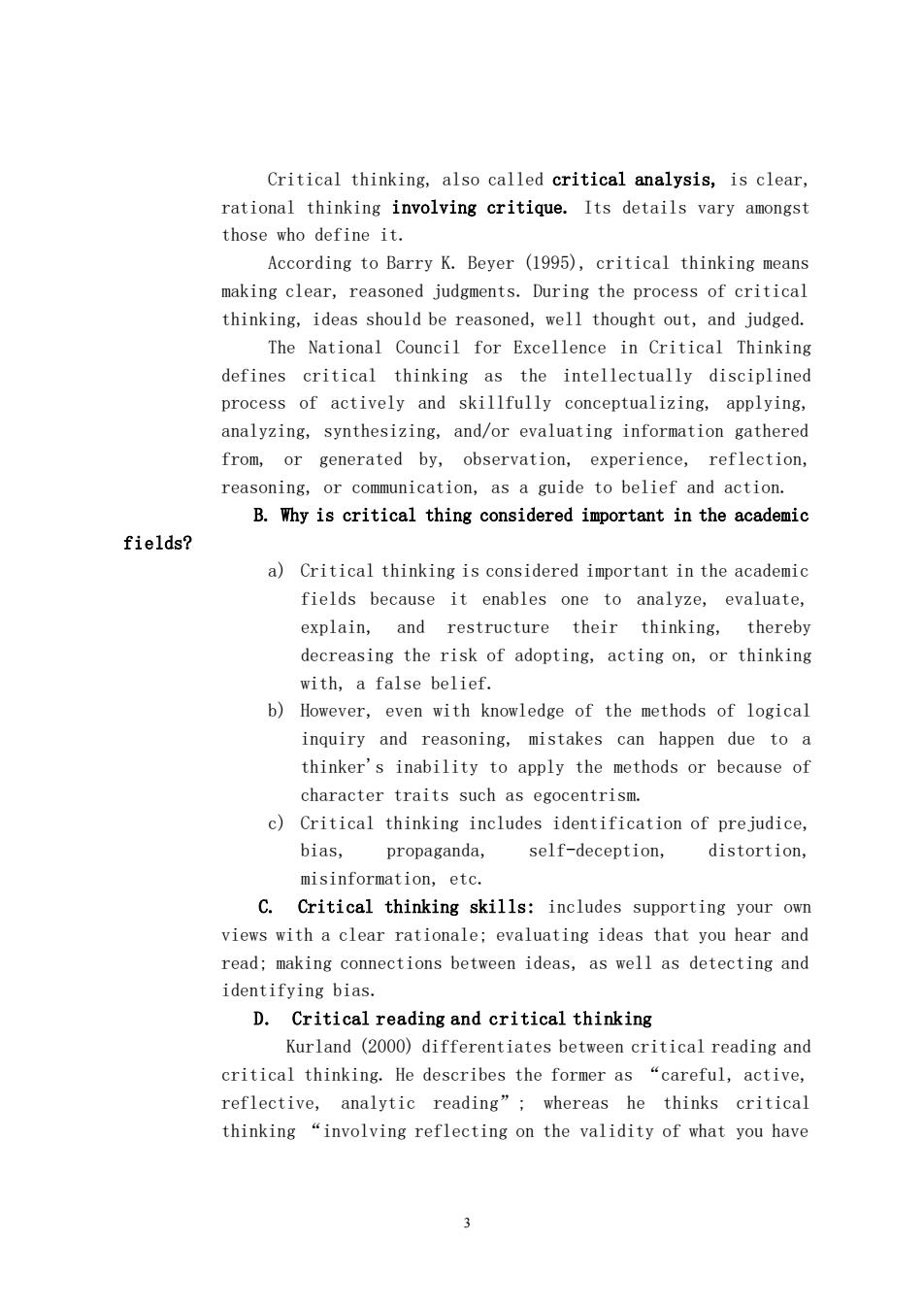
Critical thinking,also called critical analysis,is clear, rational thinking involving critique.Its details vary amongst those who define it. According to Barry K.Beyer (1995),critical thinking means making clear,reasoned judgments.During the process of critical thinking,ideas should be reasoned,well thought out,and judged. The National Council for Excellence in Critical Thinking defines critical thinking as the intellectually disciplined process of actively and skillfully conceptualizing,applying, analyzing,synthesizing,and/or evaluating information gathered from,or generated by,observation,experience,reflection, reasoning.or communication,as a guide to belief and action. B.Why is critical thing considered important in the academic fields? a)Critical thinking is considered important in the academic fields because it enables one to analyze,evaluate. explain,and restructure their thinking,thereby decreasing the risk of adopting,acting on,or thinking with,a false belief. b)However,even with knowledge of the methods of logical inquiry and reasoning,mistakes can happen due to a thinker's inability to apply the methods or because of character traits such as egocentrism. c)Critical thinking includes identification of prejudice, bias, propaganda, self-deception, distortion, misinformation,etc. C.Critical thinking skills:includes supporting your own views with a clear rationale;evaluating ideas that you hear and read;making connections between ideas,as well as detecting and identifying bias. D.Critical reading and critical thinking Kurland(2000)differentiates between critical reading and critical thinking.He describes the former as "careful,active, reflective,analytic reading";whereas he thinks critical thinking "involving reflecting on the validity of what you have 3
3 Critical thinking, also called critical analysis, is clear, rational thinking involving critique. Its details vary amongst those who define it. According to Barry K. Beyer (1995), critical thinking means making clear, reasoned judgments. During the process of critical thinking, ideas should be reasoned, well thought out, and judged. The National Council for Excellence in Critical Thinking defines critical thinking as the intellectually disciplined process of actively and skillfully conceptualizing, applying, analyzing, synthesizing, and/or evaluating information gathered from, or generated by, observation, experience, reflection, reasoning, or communication, as a guide to belief and action. B. Why is critical thing considered important in the academic fields? a) Critical thinking is considered important in the academic fields because it enables one to analyze, evaluate, explain, and restructure their thinking, thereby decreasing the risk of adopting, acting on, or thinking with, a false belief. b) However, even with knowledge of the methods of logical inquiry and reasoning, mistakes can happen due to a thinker's inability to apply the methods or because of character traits such as egocentrism. c) Critical thinking includes identification of prejudice, bias, propaganda, self-deception, distortion, misinformation, etc. C. Critical thinking skills: includes supporting your own views with a clear rationale; evaluating ideas that you hear and read; making connections between ideas, as well as detecting and identifying bias. D. Critical reading and critical thinking Kurland (2000) differentiates between critical reading and critical thinking. He describes the former as “careful, active, reflective, analytic reading”; whereas he thinks critical thinking “involving reflecting on the validity of what you have

read in the light of our prior knowledge and understanding of the world" 2)Types of writing A.Thinking about what students in higher education write a)extended essays or projects b)theses c)dissertations d)reports e)case studies f)notes g)annotations (e.g.,on handouts,photocopied originals, etc.) B.Thesis vs dissertation The terms thesis and dissertation are used differently in different countries and even in different universities in the same country In most universities in the UK,Hong Kong and Australia, a thesis is written for the research degrees of PhD and MPhil, while a much shorter dissertation is one of the final requirements for a Master's-level degree. In many American universities the terms are reversed,with theses written at Master's level and a doctoral dissertation at PhD level.For our purposes,the Hong Kong,UK and Australian terms for a PhD thesis and a taught Master's dissertation are used.See Bunton.D.(2002).Generic moves in PhD Introduction chapters.In J.Flowerdew (Ed.),Academic discourse.London: Pearson education. 3)Extended writing Extended writing:In the context of university study, extended writing is a means through which students can express views,display knowledge and demonstrate an ability to use evidence to refute or support existing theories in considerable details. 4
4 read in the light of our prior knowledge and understanding of the world”. 2) Types of writing A. Thinking about what students in higher education write a) extended essays or projects b) theses c) dissertations d) reports e) case studies f) notes g) annotations (e.g., on handouts, photocopied originals, etc.) B. Thesis vs dissertation The terms thesis and dissertation are used differently in different countries and even in different universities in the same country. In most universities in the UK, Hong Kong and Australia, a thesis is written for the research degrees of PhD and MPhil, while a much shorter dissertation is one of the final requirements for a Master’s-level degree. In many American universities the terms are reversed, with theses written at Master’s level and a doctoral dissertation at PhD level. For our purposes, the Hong Kong, UK and Australian terms for a PhD thesis and a taught Master’s dissertation are used. See Bunton, D. (2002). Generic moves in PhD Introduction chapters. In J. Flowerdew (Ed.), Academic discourse. London: Pearson Education. 3)Extended writing Extended writing: In the context of university study, extended writing is a means through which students can express views, display knowledge and demonstrate an ability to use evidence to refute or support existing theories in considerable details
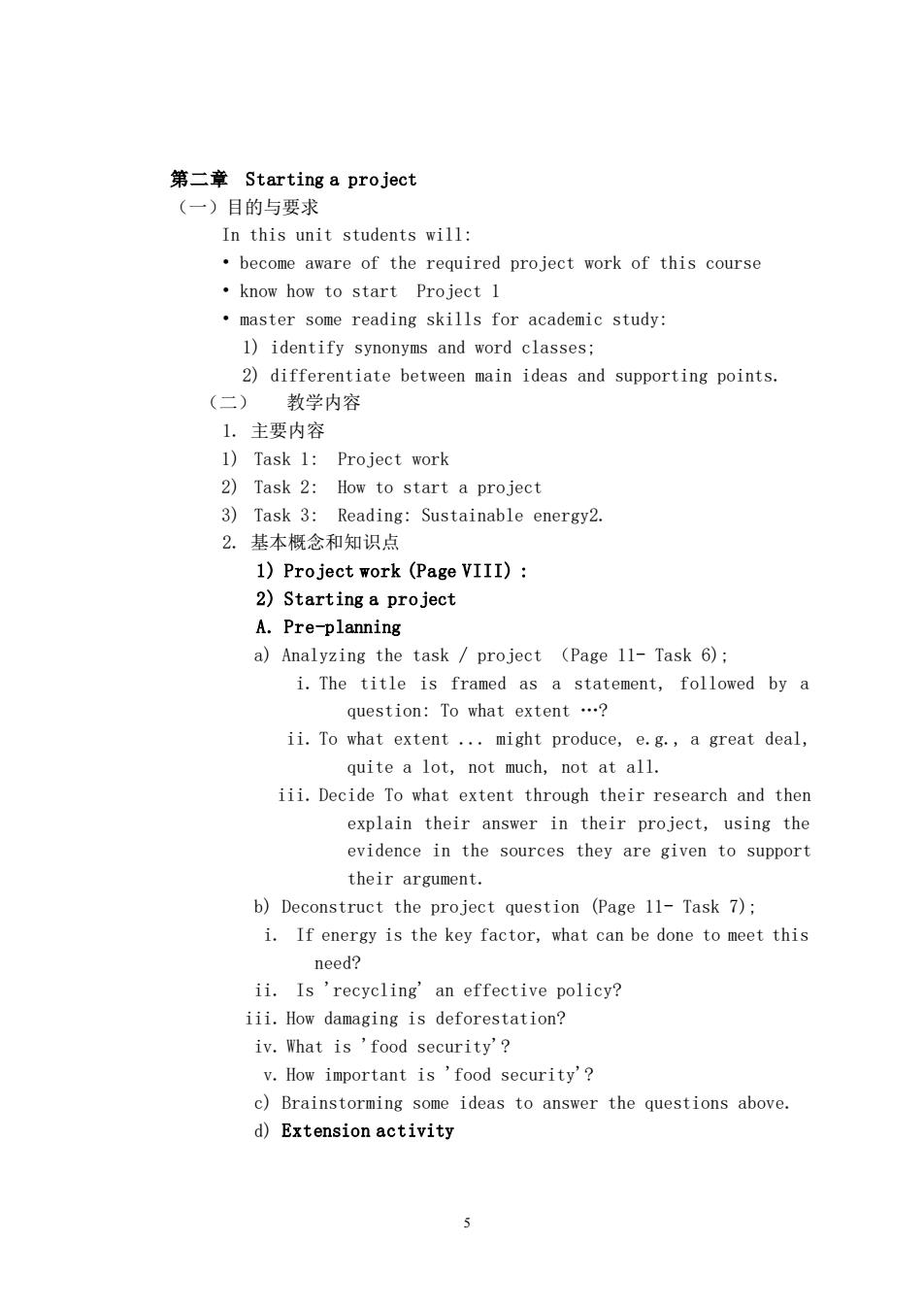
第二章Starting a project (一)目的与要求 In this unit students will: become aware of the required project work of this course know how to start Project 1 master some reading skills for academic study: 1)identify synonyms and word classes; 2)differentiate between main ideas and supporting points. (二)教学内容 1.主要内容 1)Task 1:Project work 2)Task 2:How to start a project 3)Task 3:Reading:Sustainable energy2. 2.基本概念和知识点 1)Project work (Page VIII) 2)Starting a project A.Pre-planning a)Analyzing the task project (Page 11-Task 6); i.The title is framed as a statement,followed by a question:To what extent...? ii.To what extent...might produce,e.g.,a great deal quite a lot,not much,not at all. iii.Decide To what extent through their research and then explain their answer in their project,using the evidence in the sources they are given to support their argument. b)Deconstruct the project question (Page 11-Task 7); i.If energy is the key factor.what can be done to meet this need? ii.Is 'recycling'an effective policy? iii.How damaging is deforestation? iy.What is'food security'? v.How important is'food security'? c)Brainstorming some ideas to answer the questions above. d)Extension activity 5
5 第二章 Starting a project (一)目的与要求 In this unit students will: • become aware of the required project work of this course • know how to start Project 1 • master some reading skills for academic study: 1) identify synonyms and word classes; 2) differentiate between main ideas and supporting points. (二) 教学内容 1. 主要内容 1) Task 1: Project work 2) Task 2: How to start a project 3) Task 3: Reading: Sustainable energy2. 2. 基本概念和知识点 1) Project work (Page VIII) : 2) Starting a project A. Pre-planning a) Analyzing the task / project (Page 11- Task 6); i. The title is framed as a statement, followed by a question: To what extent …? ii. To what extent ... might produce, e.g., a great deal, quite a lot, not much, not at all. iii. Decide To what extent through their research and then explain their answer in their project, using the evidence in the sources they are given to support their argument. b) Deconstruct the project question (Page 11- Task 7); i. If energy is the key factor, what can be done to meet this need? ii. Is 'recycling' an effective policy? iii. How damaging is deforestation? iv. What is 'food security'? v. How important is 'food security'? c) Brainstorming some ideas to answer the questions above. d) Extension activity
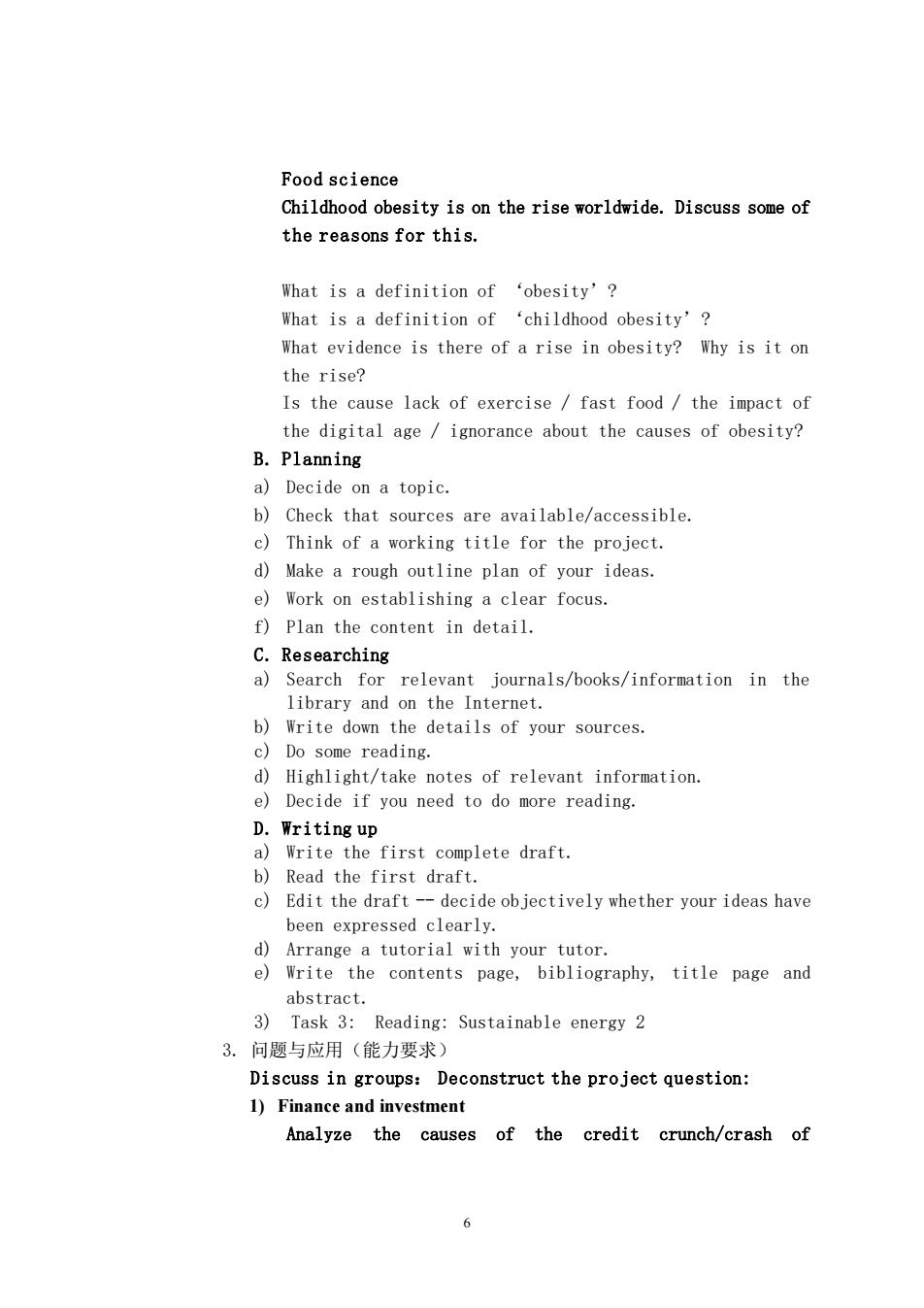
Food science Childhood obesity is on the rise worldwide.Discuss some of the reasons for this. What is a definition of‘obesity'? What is a definition of childhood obesity'? What evidence is there of a rise in obesity?Why is it on the rise? Is the cause lack of exercise fast food the impact of the digital age ignorance about the causes of obesity? B.Planning a)Decide on a topic. b)Check that sources are available/accessible c)Think of a working title for the proiect. d)Make a rough outline plan of your ideas e)Work on establishing a clear focus. f)Plan the content in detail. C.Researching a)Search for relevant journals/books/information in the library and on the Internet. b)Write down the details of your sources c)Do some reading. d)Highlight/take notes of relevant information. e)Decide if you need to do more reading. D.Writing up a)Write the first complete draft. b)Read the first draft. c)Edit the draft --decide obiectively whether your ideas have been expressed clearly dω Arrange a a tutorial with your tutor. e)Write the contents page,bibliography,title page and abstract. 3)Task 3:Reading:Sustainable energy 2 3.问题与应用(能力要求) Discuss in groups:Deconstruct the project question: 1)Finance and investment Analyze the causes of the credit crunch/crash of 6
6 Food science Childhood obesity is on the rise worldwide. Discuss some of the reasons for this. What is a definition of ‘obesity’? What is a definition of ‘childhood obesity’? What evidence is there of a rise in obesity? Why is it on the rise? Is the cause lack of exercise / fast food / the impact of the digital age / ignorance about the causes of obesity? B. Planning a) Decide on a topic. b) Check that sources are available/accessible. c) Think of a working title for the project. d) Make a rough outline plan of your ideas. e) Work on establishing a clear focus. f) Plan the content in detail. C. Researching a) Search for relevant journals/books/information in the library and on the Internet. b) Write down the details of your sources. c) Do some reading. d) Highlight/take notes of relevant information. e) Decide if you need to do more reading. D. Writing up a) Write the first complete draft. b) Read the first draft. c) Edit the draft -- decide objectively whether your ideas have been expressed clearly. d) Arrange a tutorial with your tutor. e) Write the contents page, bibliography, title page and abstract. 3) Task 3: Reading: Sustainable energy 2 3. 问题与应用(能力要求) Discuss in groups: Deconstruct the project question: 1) Finance and investment Analyze the causes of the credit crunch/crash of

2007-2008. 2)Appliedlinguistics What makes someone a good language learner?Is this something a teacher can influence? (三)思考与实践 Unit Summary Exercise:Page15-16 and Reading textbook Pagel37-142; (四)教学方法与手段 本章教学主要采用的方法和手段:课堂讲授、多媒体教学、团队合作、分 组讨论、课堂讨论。 第三章Using evidence to support your ideas (一)目的与要求 In this unit students will: discuss the importance of providing evidence in academic writing learn different methods of incorporating sources practise summarizing and paraphasing information (二)教学内容 1,主要内容 1)Selective reading for source material 2)Incorporating evidence into academic work 3)Referencing 4)Purposeful reading 5)Reading and note-making 6)Stages of writing a summary or paraphrase 7)Practice summary and paraphrase 2.基本概念和知识点 1)Introduction:Why provide evidence for supporting your ideas? A.thesis: a)a long piece of writing on a particular subject,based on original work and written for a higher (postgraduate university degree(学位)论文 b)fml.an opinion or statement put forward and supported by reasoned argument(有理论根据的)论点,论述
7 2007–2008. 2) Applied linguistics What makes someone a good language learner? Is this something a teacher can influence? (三)思考与实践 Unit Summary Exercise: Page15-16 and Reading textbook Page137-142; (四)教学方法与手段 本章教学主要采用的方法和手段: 课堂讲授、多媒体教学、团队合作、分 组讨论、课堂讨论。 第三章 Using evidence to support your ideas (一)目的与要求 In this unit students will: • discuss the importance of providing evidence in academic writing • learn different methods of incorporating sources • practise summarizing and paraphasing information (二)教学内容 1.主要内容 1) Selective reading for source material 2) Incorporating evidence into academic work 3) Referencing 4) Purposeful reading 5) Reading and note-making 6) Stages of writing a summary or paraphrase 7) Practice summary and paraphrase 2. 基本概念和知识点 1) Introduction: Why provide evidence for supporting your ideas? A. thesis: a) a long piece of writing on a particular subject, based on original work and written for a higher (postgraduate ) university degree(学位)论文 b) fml. an opinion or statement put forward and supported by reasoned argument (有理论根据的)论点, 论述
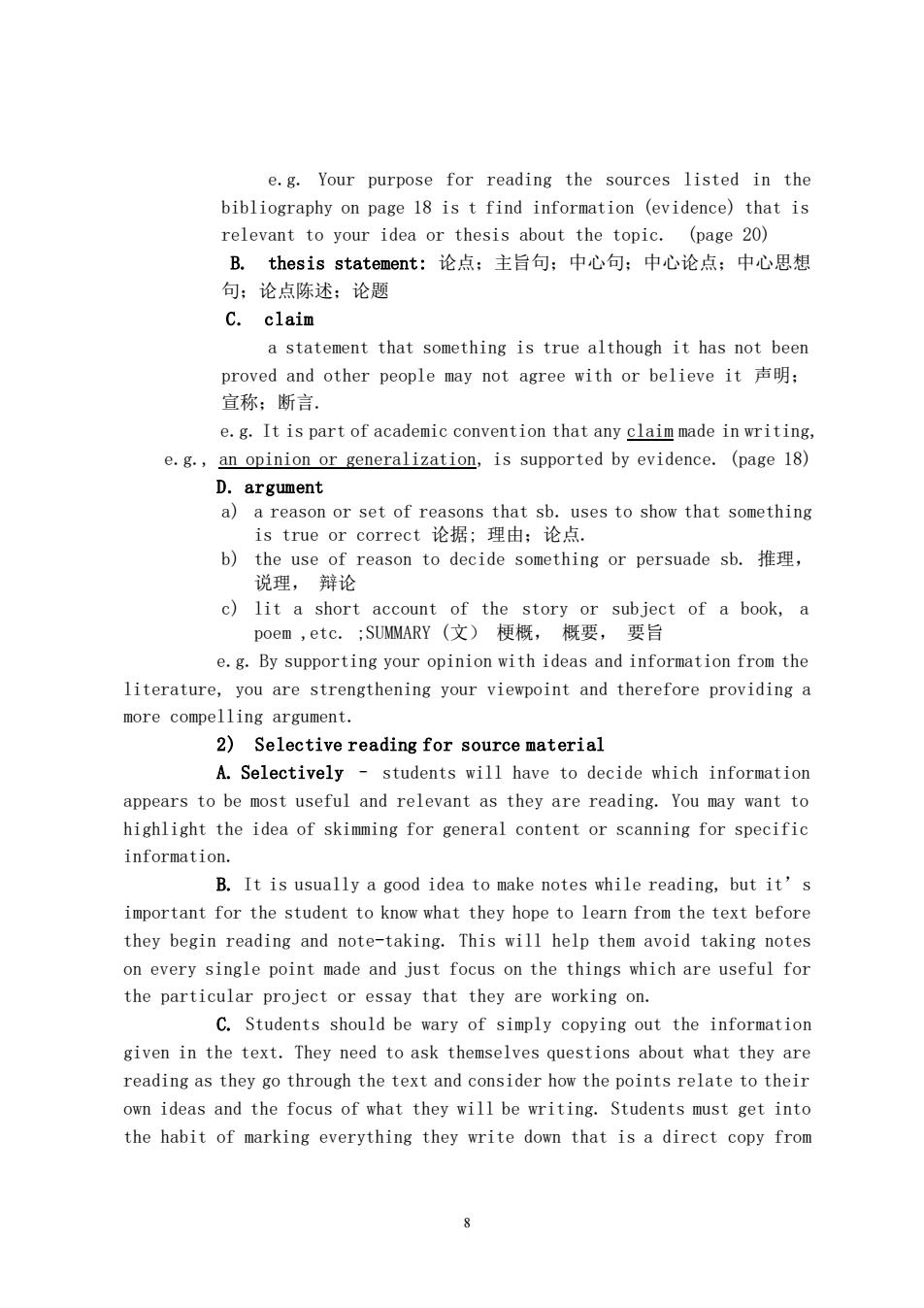
e.g.Your purpose for reading the sources listed in the bibliography on page 18 is t find information (evidence)that is relevant to your idea or thesis about the topic.(page 20) B.thesis statement:论点:主旨句:中心句:中心论点;中心思想 句:论点陈述:论题 C.claim a statement that something is true although it has not been proved and other people may not agree with or believe it声明: 宣称:断言 e.g.It is part of academic convention that any claim made in writing, e.g.,an opinion or generalization,is supported by evidence.(page 18) D.argument a)a reason or set of reasons that sb.uses to show that something is true or correct论据:理由:论点. reason to decide something or persuade sb.推理, 辩论 c)lit a short account of the story or subject of a book,a poem,etc.;SUMMARY(文)梗概,概要,要旨 e.g.By supporting your opinion with ideas and information from the literature,you are strengthening your viewpoint and therefore providing a more compelling argument. 2)Selective reading for source material A.Selectively -students will have to decide which information appears to be most useful and relevant as they are reading.You may want to highlight the idea of skimming for general content or scanning for specific information. B.It is usually a good idea to make notes while reading,but it's important for the student to know what they hope to learn from the text before they begin reading and note-taking.This will help them avoid taking notes on every single point made and just focus on the things which are useful for the particular project or essay that they are working on. C.Students should be wary of simply copying out the information given in the text.They need to ask themselves questions about what they are reading as they go through the text and consider how the points relate to their own ideas and the focus of what they will be writing.Students must get into the habit of marking everything they write down that is a direct copy from
8 e.g. Your purpose for reading the sources listed in the bibliography on page 18 is t find information (evidence) that is relevant to your idea or thesis about the topic. (page 20) B. thesis statement: 论点;主旨句;中心句;中心论点;中心思想 句;论点陈述;论题 C. claim a statement that something is true although it has not been proved and other people may not agree with or believe it 声明; 宣称;断言. e.g. It is part of academic convention that any claim made in writing, e.g., an opinion or generalization, is supported by evidence. (page 18) D. argument a) a reason or set of reasons that sb. uses to show that something is true or correct 论据; 理由;论点. b) the use of reason to decide something or persuade sb. 推理, 说理, 辩论 c) lit a short account of the story or subject of a book, a poem ,etc. ;SUMMARY (文) 梗概, 概要, 要旨 e.g. By supporting your opinion with ideas and information from the literature, you are strengthening your viewpoint and therefore providing a more compelling argument. 2) Selective reading for source material A. Selectively – students will have to decide which information appears to be most useful and relevant as they are reading. You may want to highlight the idea of skimming for general content or scanning for specific information. B. It is usually a good idea to make notes while reading, but it’s important for the student to know what they hope to learn from the text before they begin reading and note-taking. This will help them avoid taking notes on every single point made and just focus on the things which are useful for the particular project or essay that they are working on. C. Students should be wary of simply copying out the information given in the text. They need to ask themselves questions about what they are reading as they go through the text and consider how the points relate to their own ideas and the focus of what they will be writing. Students must get into the habit of marking everything they write down that is a direct copy from
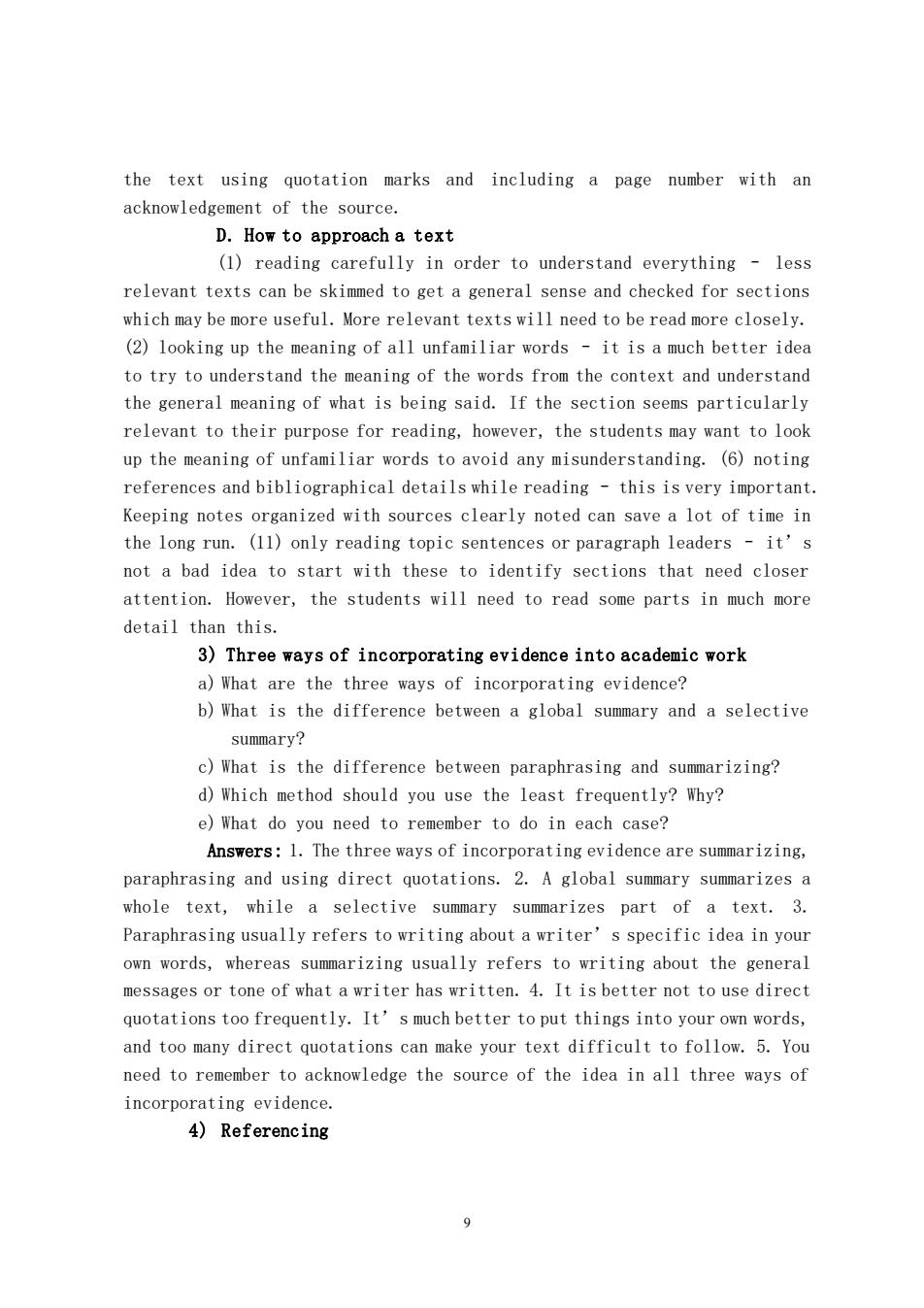
the text using quotation marks and including a page number with an acknowledgement of the source. D.How to approach a text (1)reading carefully in order to understand everything -less relevant texts can be skimmed to get a general sense and checked for sections which may be more useful.More relevant texts will need to be read more closely. (2)looking up the meaning of all unfamiliar words it is a much better idea to try to understand the meaning of the words from the context and understand the general meaning of what is being said.If the section seems particularly relevant to their purpose for reading,however,the students may want to look up the meaning of unfamiliar words to avoid any misunderstanding.(6)noting references and bibliographical details while reading-this is very important. Keeping notes organized with sources clearly noted can save a lot of time in the long run.(11)only reading topic sentences or paragraph leaders -it's not a bad idea to start with these to identify sections that need closer attention.However,the students will need to read some parts in much more detail than this. 3)Three ways of incorporating evidence into academic work a)What are the three ways of incorporating evidence? b)What is the difference between a global summary and a selective summary? c)What is the difference between paraphrasing and summarizing? d)Which method should you use the least frequently?Why? e)What do you need to remember to do in each case? Answers:1.The three ways of incorporating evidence are summarizing, paraphrasing and using direct quotations.2.A global summary summarizes a whole text,while a selective summary summarizes part of a text.3. Paraphrasing usually refers to writing about a writer's specific idea in your own words,whereas summarizing usually refers to writing about the general messages or tone of what a writer has written.4.It is better not to use direct quotations too frequently.It's much better to put things into your own words, and too many direct quotations can make your text difficult to follow.5.You need to remember to acknowledge the source of the idea in all three ways of incorporating evidence. 4)Referencing
9 the text using quotation marks and including a page number with an acknowledgement of the source. D. How to approach a text (1) reading carefully in order to understand everything – less relevant texts can be skimmed to get a general sense and checked for sections which may be more useful. More relevant texts will need to be read more closely. (2) looking up the meaning of all unfamiliar words – it is a much better idea to try to understand the meaning of the words from the context and understand the general meaning of what is being said. If the section seems particularly relevant to their purpose for reading, however, the students may want to look up the meaning of unfamiliar words to avoid any misunderstanding. (6) noting references and bibliographical details while reading – this is very important. Keeping notes organized with sources clearly noted can save a lot of time in the long run. (11) only reading topic sentences or paragraph leaders – it’s not a bad idea to start with these to identify sections that need closer attention. However, the students will need to read some parts in much more detail than this. 3) Three ways of incorporating evidence into academic work a) What are the three ways of incorporating evidence? b) What is the difference between a global summary and a selective summary? c) What is the difference between paraphrasing and summarizing? d) Which method should you use the least frequently? Why? e) What do you need to remember to do in each case? Answers: 1. The three ways of incorporating evidence are summarizing, paraphrasing and using direct quotations. 2. A global summary summarizes a whole text, while a selective summary summarizes part of a text. 3. Paraphrasing usually refers to writing about a writer’s specific idea in your own words, whereas summarizing usually refers to writing about the general messages or tone of what a writer has written. 4. It is better not to use direct quotations too frequently. It’s much better to put things into your own words, and too many direct quotations can make your text difficult to follow. 5. You need to remember to acknowledge the source of the idea in all three ways of incorporating evidence. 4) Referencing

Direct reference and indirect reference 5)Reading and note-making Five stages for developing summarizing skills A.Decide why b.Understand the material C.Making Notes D.Put the original away E.Check against the original text Study the features of a good summary 6)Stages of writing a summary or paraphrase NOW approach:Note:making notes on the main points Organize:organizing these notes Write:writing up the notes in an appropriate format 7)Practice making notes A.Three types of notes B.How to make notes and write a summary accordingly Linear notes ·Key words and phrases Headings and sub-headings,underlining,use of bold. Numbering or bullet points ·Phrases ·Abbreviations Margins to put in additional points ·Spacing One side of the page only Useful when there is a clear structure Mind Maps These are a pictorial way of organising your thoughts and ideas.They are said to resemble the way the brain works,with the topic in the middle of the page and the ideas flowing outwards.The visual nature of the notes can make it easier to understand and remember information. Writing is kept to a minimum and links between sections can be more obvious. You can use colour,diagrams,pictures,and symbols 10
10 Direct reference and indirect reference 5) Reading and note-making Five stages for developing summarizing skills A. Decide why B. Understand the material C. Making Notes D. Put the original away E. Check against the original text Study the features of a good summary 6) Stages of writing a summary or paraphrase NOW approach: Note: making notes on the main points Organize: organizing these notes Write: writing up the notes in an appropriate format 7) Practice making notes A. Three types of notes B. How to make notes and write a summary accordingly Linear notes • Key words and phrases. • Headings and sub-headings, underlining, use of bold. • Numbering or bullet points • Phrases • Abbreviations • Margins to put in additional points • Spacing • One side of the page only • Useful when there is a clear structure Mind Maps These are a pictorial way of organising your thoughts and ideas. They are said to resemble the way the brain works, with the topic in the middle of the page and the ideas flowing outwards. The visual nature of the notes can make it easier to understand and remember information. Writing is kept to a minimum and links between sections can be more obvious. You can use colour, diagrams, pictures, and symbols